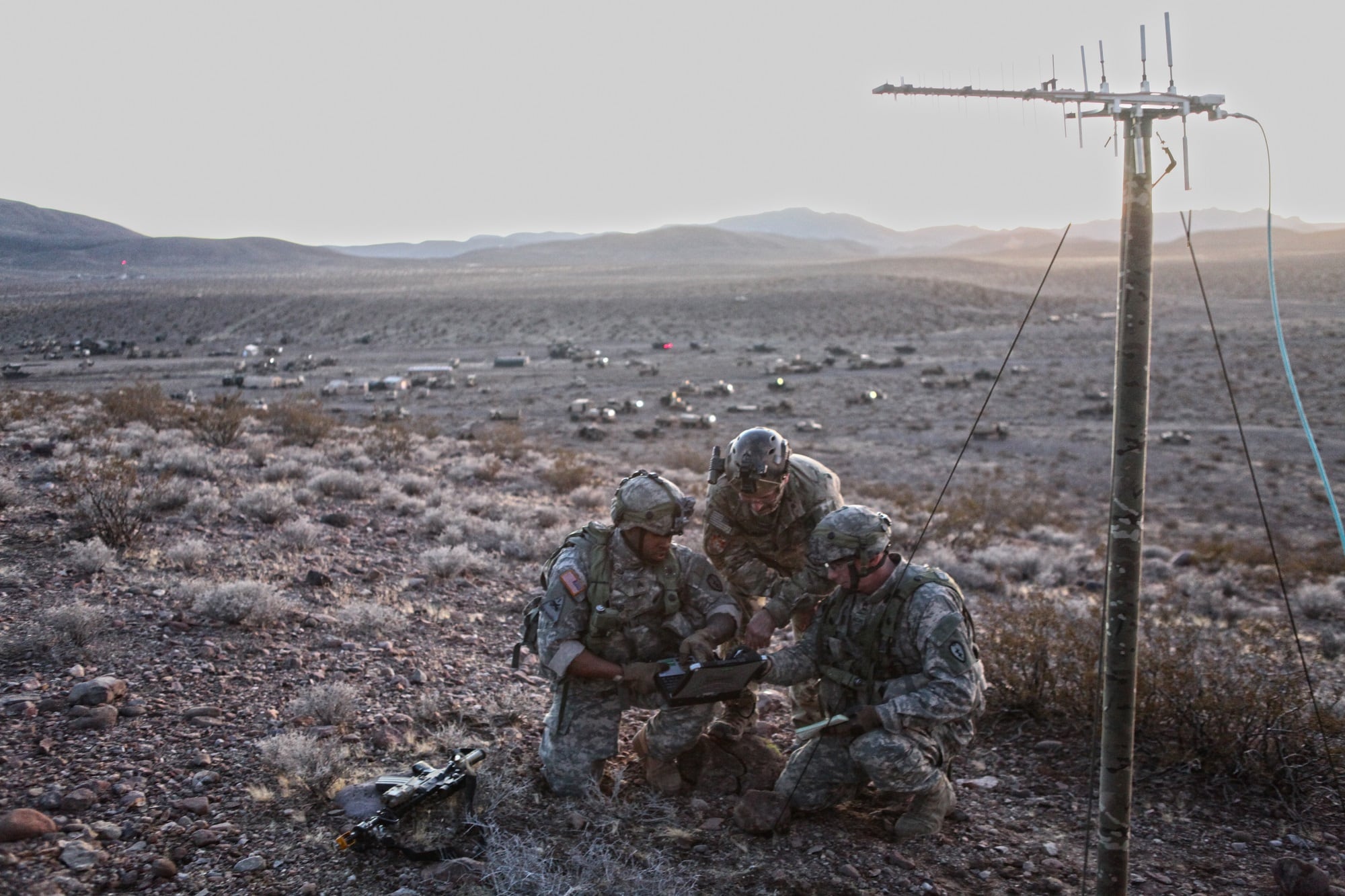Many senior leaders admit the Army divested a lot of its electronic warfare capability over the last decade-plus, so the service is currently undergoing efforts aimed at injecting capability back into formations.
One way is the Army is beginning to fuse intelligence and electronic warfare at a broad strategic level, as well as in integrated capabilities to be used by new tactical formations.
At the broad level, the Army recently authored what’s known as an initial capabilities document regarding the Terrestrial Layer Intelligence Support to Multi-domain and Joint Combined Arms Maneuver concepts. This document outlines problems across intelligence disciplines.
On the platform side, the Army has decided to scrap its primary program that sought to deliver ground and vehicle forces organic electronic warfare capability — known as Multifunctional Electronic Warfare ground — and replace it with the Terrestrial Layer System (TLS).
TLS will be a signals intelligence/electronic warfare system projected to be fielded on vehicles. Moreover, it is expected that TLS will be used by new military intelligence-electronic warfare (MI-EW) companies the Army is working to stand up.
RELATED

SIGINT v. EW
The fusion of signals intelligence and electronic warfare stems from years of debate surrounding delineations of the two.
There has been an ongoing debate within the military as it relates to SIGINT and EW. While operations are critically reliant on intelligence, intelligence capabilities and authorities are held at much higher classification levels and under different rules versus EW operations, which are conducted at lower classification levels and at the tactical and operational level of war.
“Some are questioning what used to be considered traditional SIGINT. What we are talking about is really sensing the environment and being able to look at the externals and what it is — radio or radar, friendly or foe,” Dave May, an intelligence advisor for the Cyber Center of Excellence, said during a conference last August.
“We made the decision in the Army a while back to separate intel from EW; the other services did not. Those in the business think that process is SIGINT. This is being debated today.”
In other words, on the intelligence collection side, many wonder whether EW collection is being done for Title 50 purposes, the portion of the U.S. code that pertains to intelligence, or if it is sensing for combat information and target information in regard to Title 10, the portion of the U.S. code that pertains to military operations.
“There is a SIGINT portion and that’s … at the time of collect is that truly combat-raw information. And at what point do you say that is going over to the Title 50 side of the house?” Maj. Gen. Patricia Frost, director of cyber in the Office of the Deputy Chief of Staff G-3/5/7, told C4ISRNET last year.
“That is a lot of what we’re doing in the [cyber and electromagnetic activities] optimization: is understand when you look at platform integration … technically we can do a lot of things on a platform, [but] do we have the authorities to integrate these capabilities?”
Currently, under an Army directive, the relevant stakeholders are trying to clarify the EW support mission, which involves the collection and identification of signals, and the SIGINT mission as those in the community see them as complementary but not contradictory, Lt. Col. Chris Walls, deputy division chief for strategy and policy in the cyber directorate, said at the C4ISRNET conference.
“EW soldiers can conduct the electronic warfare support mission and are not conducting SIGINT activities,” he said. “We want to free them up to be able to do their mission separate and distinct from the SIGINT mission.”
Walls added that while the SIGINT mission is absolutely critical for EW personnel in characterizing signals and telling them what they’re observing in the electromagnetic spectrum, they want to make sure EW soldiers aren’t hindered in conducting EW support missions by forcing them to do them under SIGINT authorities.
Force design updates
With the fusion of these disciplines taking place as a means to empower soldiers more at the tactical edge, the Army is standing up MI-EW companies.
These companies will help restore EW capabilities into brigade combat team formations, officials have said. The existing military intelligence force structure will be leveraged to come up with an MI-EW company to bring those capabilities to bear.
The force design updates are pending, according to Maj. Gen. John Morrison, commander of the Cyber Center of Excellence, speaking to C4ISRNET on the sidelines of the AFCEA Defensive Cyber Operations symposium in early May.
Equipping these tactical formations and getting some “meat” behind this capability is the No. 1 goal for the Army’s top intelligence officer.
What’s driving the need for this platform is the Army’s need to get at the electromagnetic spectrum control and adversarial capabilities that Russians and Chinese have exhibited, Lt. Gen. Scott Berrier, the Army’s director of intelligence, told C4ISRNET following a keynote presentation in Springfield, Virginia, in early March.
Morrison said this will provide an “integrated capability with our MI teammates and provide the commander operational flexibility.”
The combined effort came about as the capability requirements generators for intelligence and electronic warfare realized they were developing requirements documents with a roughly 85 to 90 percent overlap, Col. Mark Dotson, Army Training and Doctrine Command capability manager for EW and spectrum management operations, said at the C4ISRNET conference in May.
“One requirement mov[ing] forward from both the intelligence perspective for the SIGINT side of the house and from the electronic warfare side,” he said.
Dotson said the Army is working to get the first ground system approved this fiscal year, which will be for the Terrestrial Layer System type of truck.
Following requirements for that, he said, would come the other parts, such as the dismounted capability from that truck or a more high-powered capability that’s going to be less mobile but have more jamming power or more sensing ability.
Mark Pomerleau is a reporter for C4ISRNET, covering information warfare and cyberspace.








